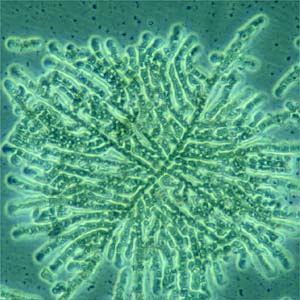Coleochaete irregularis Pringsheim
Classification: Eukarya, Charophyta, Charophyceae, Coleochaetales, Coleochaetaceae
Synonomy:
Description: Up to 0.5 mm dia, closely appressed to substrate. Thallus may be roughly circular in outline, but margin is usually irregular. Branching typically occurs in 2nd subapical cell, and gives rise to a filament growing at right angles to the parent filament. Crowding among the filaments forces the thallus into a roughly circular outline. In culture a distinct layer of mucilage is apparent, but this is often inconspicuous in nature. Hairs are inserted laterally, arising from one side of the vegetative cell close to the substrate. Cytoplasm has a distinctive granular appearance, perhaps attributable to lipid droplets. Antheridia are flask-shaped. Vegetative filaments cover the zygote only on the upper surface. Zoospore germination gives rise to a filament, with branching occuring only after the filament is several cells in length.
Distinguished from C. orbiularis and C. scutata by appearance of cytoplasm, chloroplast shape, sub-apical branching, irregular thallus margin, and absence of cortication on zygotes. Distinguished from C. circularis by the absence of apical branching.

C. irregularis in culture,
isolated from Lake Tomohawk, Oneida Co., WI.
Thallus ca. 100 micrometers diameter. Phase micrograph. [CFD]
Additional Information
This species represents a lineage of Coleochaete quite distinct from the better-known C. orbicularis, C. scutata, and C. pulvinata.
How to find it: Occurs worldwide, in both temperate and tropical areas. Found on the stems of aquatic plants and other solid surfaces in still or slow-moving fresh water. Requires oligotrophic to mesotrophic conditions.
How to grow it: Unialgal cultures can be established by micropipette isolation of zoospores and meiospores. Grows well in Guillard's Freshwater Medium.
Key Literature: Pringsheim, 1860. Jahrb. Wiss. Bot. 2:1-36.